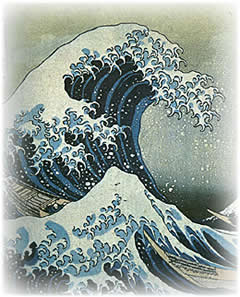Tsunami Hazard: Introduction
 |

From ukiyo-e print by Hokusai c1830
The word Tsunami was coined by the Japanese
and literally translates to "great wave in harbour"
|
The Boxing Day 2004 tsunami tragedy focussed the world’s attention to the powerful and devastating nature of the tsunami phenomenon. No longer is a tsunami warning the trigger for curious people to visit the coast to see what happens next. Now there is an understanding to flee to higher ground and away from the coast. This module is designed to introduce you to the tsunami phenomenon, how tsunamis are formed, their characteristics, and some case studies from the Pacific region, finishing with the 2004 event in the Indian Ocean.
A Tsunami is a series of large ocean waves generated by impulses
from geophysical events (earthquakes, landslides and volcanic eruptions)
on the ocean bottom or along the coastline. The word Tsunami was
coined by the Japanese (who suffer more than most from this type
of natural hazard), and literally translates to "great wave
in harbour".
Learning Outcomes
On
completion of this module you should be able to define, describe
and explain the many causes of tsunamis. You will be expected to
describe their global occurrence, the hazard they represent, and
be able to give an account of the case history of 5 famous tsunamis
in the Pacific between 1946 and 1992. Finally you will learn about
the Pacific Tsunami Warning Center, the potential for local tsunami
warning systems and tsunami hazard mapping.
|

